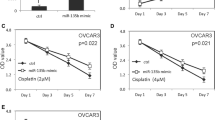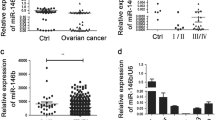Abstract
In order to determine the expression pattern of miR-101 in epithelial ovarian neoplasms and assess the functions and mechanism of miR-101 in tumorigenesis, we detected the expression of miR-101 and zeste homolog 2 (EZH2) in normal, benign, and malignant ovarian tissues and used miR-101 lentivirus infection to increase miR-101 expression in ovarian cancer cells and drug-resistant cancer cells. We found that miR-101 was underexpressed in epithelial ovarian cancer tissues, which significantly correlated with poor cell differentiation, advanced International Federation of Gynecology and Obstetrics (FIGO) stages, and ovarian cancer cell cisplatin resistance. miR-101 overexpression decreased the expression of EZH2, reduced proliferation and migration of ovarian cancer cells, and resensitized drug-resistant cancer cells to cisplatin-induced cytotoxicity, suggesting the important role miR-101 plays in ovarian cancer that may be associated with its function as a regulator targeting EZH2. Our findings show the potential of miR-101 as a diagnostic marker and new therapeutic target for patients with epithelial ovarian cancer.




Similar content being viewed by others
References
Moss C, Kaye SB. Ovarian cancer: progress and continuing controversies in management. Eur J Cancer. 2002;38:1701–7.
Aghajanian C. Clinical update: novel targets in gynecologic malignancies, Vol. 31. Elsevier; 2004; p. 22–26.
Lynam-Lennon N, Maher SG, Reynolds JV. The roles of microRNA in cancer and apoptosis. Biol Rev Camb Philos Soc. 2009;84:55–71.
Behm-Ansmant I, Rehwinkel J, Izaurralde E. MicroRNAs silence gene expression by repressing protein expression and/or by promoting mRNA decay. Cold Spring Harb Symp Quant Biol. 2006;71:523–30.
Zhang B, Pan X, Cobb GP, Anderson TA. microRNAs as oncogenes and tumor suppressors. Dev Biol. 2007;302:1–12.
Sorrentino A, Liu CG, Addario A, Peschle C, Scambia G, Ferlini C. Role of microRNAs in drug-resistant ovarian cancer cells. Gynecol Oncol. 2008;111:478–86.
Yang H, Kong W, He L, et al. MicroRNA expression profiling in human ovarian cancer: miR-214 induces cell survival and cisplatin resistance by targeting PTEN. Cancer Res. 2008;68:425–33.
Li Z, Hu S, Wang J, et al. MiR-27a modulates MDR1/P-glycoprotein expression by targeting HIPK2 in human ovarian cancer cells. Gynecol Oncol. 2010;119:125–30.
Jacobs JJ, van Lohuizen M. Polycomb repression: from cellular memory to cellular proliferation and cancer. Biochim Biophys Acta. 2002;1602:151–61.
Cao R, Zhang Y. The functions of E(Z)⁄EZH2-mediated methylation of lysine 27 in histone H3. Curr Opin Genet Dev. 2004;14:155–64.
Hu S, Yu L, Li Z, et al. Overexpression of EZH2 contributes to acquired cisplatin resistance in ovarian cancer cells in vitro and in vivo. Cancer Biol Ther. 2010;10:788–95.
Guo J, Cai J, Yu L, Tang H, Chen C, Wang Z. EZH2 regulates expression of p57 and contributes to progression of ovarian cancer in vitro and in vivo. Cancer Sci. 2011;102:530–9.
Strillacci A, Griffoni C, Sansone P, et al. MiR-101 downregulation is involved in cyclooxygenase-2 overexpression in human colon cancer cells. Exp Cell Res. 2009;315:1439–47.
Su H, Yang JR, Xu T, et al. MicroRNA-101, down-regulated in hepatocellular carcinoma, promotes apoptosis and suppresses tumorigenicity. Cancer Res. 2009;69:1135–42.
Varambally S, Cao Q, Mani RS, et al. Genomic loss of microRNA-101 leads to overexpression of histone methyltransferase EZH2 in cancer. Science. 2008;32:1695–9.
Livak KJ, Schmittgen TD. Analysis of relative gene expression data using real-time quantitative PCR and the 2(-Delta Delta C(T) method. Methods. 2001;25:402–8.
Friedman J, Liang G, Liu C, et al. The putative tumor suppressor microRNA-101 modulates the cancer epigenome by repressing the polycomb group protein EZH2. Cancer Res. 2009;69:2623.
Assaad S, Qazi AM, et al. MicroRNA-101 Inhibits Growth of Epithelial Ovarian Cancer by Relieving Chromatin-Mediated Transcriptional Repression of p21waf1/cip1. Pharm Res. 2011;28:3079–90.
Zhang JG, Guo JF, Liu DL, et al. MicroRNA-101 exerts tumor-suppressive functions in non-small cell lung cancer through directly targeting enhancer of zeste homolog 2. J Thorac Oncol. 2011;6:671–8.
Pogribny IP, Filkowski JN, Tryndyak VP, et al. Alterations of microRNAs and their targets are associated with acquired resistance of MCF-7 breast cancer cells to cisplatin. Int J Cancer. 2010;127:1785–94.
Xu L, Beckebaum S, Iacob S, et al. MicroRNA-101 inhibits human hepatocellular carcinoma progression through EZH2 downregulation and increased cytostatic drug sensitivity. J Hepatol. 2014;60:590–8.
Baylin SB. Resistance, epigenetics and the cancer ecosystem. Nat Med. 2011;17:288–9.
Sachdeva M, Wu H, Ru P, Hwang L, Trieu V, Mo YY. MicroRNA-101-mediated Akt activation and estrogen-independent growth. Oncogene. 2011;30:822–31.
Rao X, Di Leva G, Li M, et al. MicroRNA-221/222 confers breast cancer fulvestrant resistance by regulating multiple signaling pathways. Oncogene. 2011;30:1082–97.
Siddik ZH. Biochemical and molecular mechanisms of cisplatin resistance. Cancer Treat Res. 2002;112:263–84.
Acknowledgments
This work was supported by grants from the National Natural Science Foundation of China (No. 81202058) and from the Hubei Province Natural Science Foundation of China (No. 2013CFB128 and 2012FFB02334).
Conflicts of interest
The authors have no conflict of interest.
Author information
Authors and Affiliations
Corresponding author
Additional information
Lin Liu and Jianfeng Guo contributed equally to this work.
Rights and permissions
About this article
Cite this article
Liu, L., Guo, J., Yu, L. et al. miR-101 regulates expression of EZH2 and contributes to progression of and cisplatin resistance in epithelial ovarian cancer. Tumor Biol. 35, 12619–12626 (2014). https://doi.org/10.1007/s13277-014-2585-6
Received:
Accepted:
Published:
Issue Date:
DOI: https://doi.org/10.1007/s13277-014-2585-6




